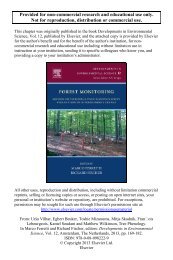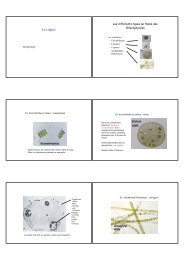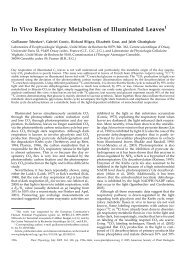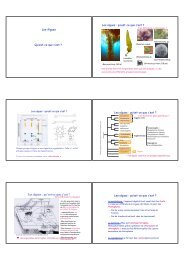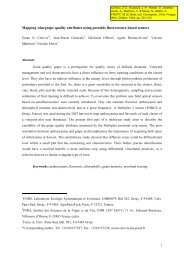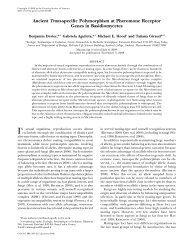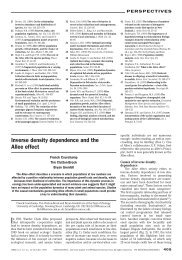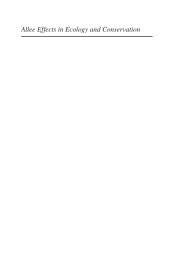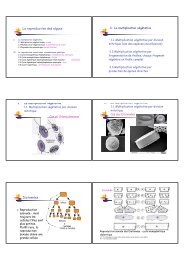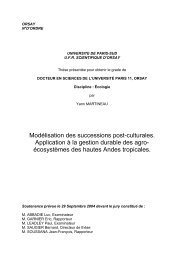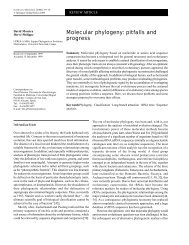222 ResearchNewPhytologistFamily CaryophyllaceaeSubfamily CaryophylloideaeTable 2 Number <str<strong>on</strong>g>of</str<strong>on</strong>g> diseased specimensfound in herbaria, classified by plant genusand life-spanTotal Perennial Annual UndeterminedTribe Sileneae Silene 316 (95) 316 (95) 0 (0) 0 (0)Lychnis 32 (7) 32 (7) 0 (0) 0 (0)Heliosperma 1 (1) 1 (1) 0 (0) 0 (0)Viscaria 10 (2) 10 (2) 0 (0) 0 (0)Atoci<strong>on</strong> 3 (2) 3 (2) 0 (0) 0 (0)Eudian<str<strong>on</strong>g>the</str<strong>on</strong>g> 0 (0) 0 (0) 0 (0) 0 (0)Agrostemma 0 (0) 0 (0) 0 (0) 0 (0)Remaining Caryophylloideae Sap<strong>on</strong>aria 1 (1) 1 (1) 0 (0) 0 (0)Dianthus 9 (2) 9 (2) 0 (0) 0 (0)Petrorhagia 0 (0) 0 (0) 0 (0) 0 (0)Remaining Caryophyllaceae Stellaria 1 (1) 1 (1) 0 (0) 0 (0)Family Portulaceae Calandrinia 18 (3) 18 (3) 0 (0) 0 (0)Cistan<str<strong>on</strong>g>the</str<strong>on</strong>g> 0 (0) 0 (0) 0 (0) 0 (0)Ceraria 0 (0) 0 (0) 0 (0) 0 (0)Calyptro<str<strong>on</strong>g>the</str<strong>on</strong>g>ca 0 (0) 0 (0) 0 (0) 0 (0)Total 391 (114) 391 (114) 0 (0) 0 (0)Numbers <str<strong>on</strong>g>of</str<strong>on</strong>g> <strong>species</strong> with disease per genus are shown in paren<str<strong>on</strong>g>the</str<strong>on</strong>g>ses.ResultsRates <str<strong>on</strong>g>of</str<strong>on</strong>g> diseaseThe herbarium surveys included 42 707 specimens from952 plant <strong>species</strong>, with <str<strong>on</strong>g>the</str<strong>on</strong>g> great majority bel<strong>on</strong>ging to tribeSileneae and to o<str<strong>on</strong>g>the</str<strong>on</strong>g>r members <str<strong>on</strong>g>of</str<strong>on</strong>g> <str<strong>on</strong>g>the</str<strong>on</strong>g> Caryophylloideae subfamily(Table 1). An<str<strong>on</strong>g>the</str<strong>on</strong>g>r-smut disease was found <strong>on</strong> 391herbarium specimens, which corresp<strong>on</strong>ded to disease <strong>on</strong>114 plant <strong>species</strong> (Table 2). An<str<strong>on</strong>g>the</str<strong>on</strong>g>r-smut disease was presentexclusively in perennial <strong>species</strong> and not in annuals(1.38% am<strong>on</strong>g 28 379 specimens <str<strong>on</strong>g>of</str<strong>on</strong>g> perennials, and nocases <str<strong>on</strong>g>of</str<strong>on</strong>g> disease am<strong>on</strong>g 14 101 specimens <str<strong>on</strong>g>of</str<strong>on</strong>g> annuals).Disease occurred <strong>on</strong> perennial <strong>species</strong> <str<strong>on</strong>g>of</str<strong>on</strong>g> all major tax<strong>on</strong>omicgroups examined in this study (Table 2). Thecomplete <strong>species</strong> list represents <str<strong>on</strong>g>the</str<strong>on</strong>g> most inclusive survey <str<strong>on</strong>g>of</str<strong>on</strong>g>this group to date (see Table S1 ).The annual ⁄ perennial status <str<strong>on</strong>g>of</str<strong>on</strong>g> some <strong>species</strong> could not bedetermined from <str<strong>on</strong>g>the</str<strong>on</strong>g> literature (Table 1), but n<strong>on</strong>e <str<strong>on</strong>g>of</str<strong>on</strong>g> <str<strong>on</strong>g>the</str<strong>on</strong>g>sewas found to be diseased and most were represented by veryfew specimens (average = 1.9). The average number <str<strong>on</strong>g>of</str<strong>on</strong>g>specimens per <strong>species</strong> was 42 for perennials and 55 forannuals. Herbarium specimens labeled <strong>on</strong>ly with <str<strong>on</strong>g>the</str<strong>on</strong>g> genusname (e.g. ‘Silene indet.’) were examined but not includedin fur<str<strong>on</strong>g>the</str<strong>on</strong>g>r analyses; an<str<strong>on</strong>g>the</str<strong>on</strong>g>r-smut disease was found <strong>on</strong> four<str<strong>on</strong>g>of</str<strong>on</strong>g> 178 Silene indet. specimens and four <str<strong>on</strong>g>of</str<strong>on</strong>g> 26 Lychnis indet.specimens.In <str<strong>on</strong>g>the</str<strong>on</strong>g> tribe Sileneae, an estimated 84% <str<strong>on</strong>g>of</str<strong>on</strong>g> all perennial<strong>species</strong> are likely to be hosts to an<str<strong>on</strong>g>the</str<strong>on</strong>g>r-smut diseasein nature based <strong>on</strong> <str<strong>on</strong>g>the</str<strong>on</strong>g> data for <strong>species</strong> with a probability<str<strong>on</strong>g>of</str<strong>on</strong>g> not finding disease <str<strong>on</strong>g>of</str<strong>on</strong>g> < 0.05 (i.e. 26 out <str<strong>on</strong>g>of</str<strong>on</strong>g> 31<strong>species</strong> with > 210 specimens having at least <strong>on</strong>e thatwas diseased). Similar estimates were obtained by includingSileneae perennials with fewer herbarium specimens(i.e. where <str<strong>on</strong>g>the</str<strong>on</strong>g> probability <str<strong>on</strong>g>of</str<strong>on</strong>g> not finding disease if itwere present was statistically less significant); <str<strong>on</strong>g>the</str<strong>on</strong>g> percentage<str<strong>on</strong>g>of</str<strong>on</strong>g> <strong>species</strong> found to be diseased was 82% for<strong>species</strong> with a P-value for not finding disease < 0.1(n = 39 <strong>species</strong>, each with > 170 specimens), and 76%for a P-value < 0.2 (n = 54 <strong>species</strong>, each with > 120specimens).The simulati<strong>on</strong> approach to estimate <str<strong>on</strong>g>the</str<strong>on</strong>g> proporti<strong>on</strong> <str<strong>on</strong>g>of</str<strong>on</strong>g>perennial <strong>species</strong> with disease provided a comparable value<str<strong>on</strong>g>of</str<strong>on</strong>g> 81%. The percentage <str<strong>on</strong>g>of</str<strong>on</strong>g> examined Sileneae <strong>species</strong> thatwere classified as perennials vs annual was 79%. Therefore,with an<str<strong>on</strong>g>the</str<strong>on</strong>g>r-smut disease <strong>on</strong> roughly 80% <str<strong>on</strong>g>of</str<strong>on</strong>g> perennials andan estimated 750–850 extant Sileneae <strong>species</strong> (e.g. Oxelmanet al., 2001; Eggens et al., 2007), it is predicted thatbetween 470 and 530 <strong>species</strong> might be diseased in naturefor this tribe al<strong>on</strong>e.Am<strong>on</strong>g <str<strong>on</strong>g>the</str<strong>on</strong>g> perennial Sileneae <strong>species</strong> where fewerdiseased specimens were found than expected, <strong>on</strong>ly Silenestellata, with no disease am<strong>on</strong>g 824 specimens, had abinomial distributi<strong>on</strong> probability < 0.05 <str<strong>on</strong>g>of</str<strong>on</strong>g> having diseasebased <strong>on</strong> <str<strong>on</strong>g>the</str<strong>on</strong>g> overall average incidence <str<strong>on</strong>g>of</str<strong>on</strong>g> disease in perennialsafter correcti<strong>on</strong> for multiple independent tests (P-valuecorrected for 450 independent tests <str<strong>on</strong>g>of</str<strong>on</strong>g> perennials withoutdisease = 0.008). O<str<strong>on</strong>g>the</str<strong>on</strong>g>r <strong>species</strong> with large numbers <str<strong>on</strong>g>of</str<strong>on</strong>g> specimensbut where no disease was found included Silenefortunei (411 specimens) and Silene involucrata (403 specimens),but for <str<strong>on</strong>g>the</str<strong>on</strong>g>se to be significant would require fewerthan 13 independent tests.New Phytologist (2010) 187: 217–229www.newphytologist.comÓ The Authors (2010)Journal compilati<strong>on</strong> Ó New Phytologist Trust (2010)
NewPhytologist Research 223Species with statistically greater numbers <str<strong>on</strong>g>of</str<strong>on</strong>g> diseasedspecimens than expected based <strong>on</strong> binomial distributi<strong>on</strong>probabilities included Silene saxifraga (32 diseased specimensam<strong>on</strong>g 491 specimens), Lychnis fulgens (13 am<strong>on</strong>g116 specimens), and Silene parryi (21 am<strong>on</strong>g 373 specimens).Analysis <str<strong>on</strong>g>of</str<strong>on</strong>g> <str<strong>on</strong>g>the</str<strong>on</strong>g> host phylogeny revealed that perennialswith high disease frequencies were found toge<str<strong>on</strong>g>the</str<strong>on</strong>g>r inmultiple well-supported clades ei<str<strong>on</strong>g>the</str<strong>on</strong>g>r with perennialshaving low or no disease, or with annual <strong>species</strong> (Fig. 1).There was no statistically significant evidence for a phylogeneticsignal for ei<str<strong>on</strong>g>the</str<strong>on</strong>g>r annual vs perennial life-span orpresence or absence <str<strong>on</strong>g>of</str<strong>on</strong>g> disease; that is, <str<strong>on</strong>g>the</str<strong>on</strong>g> estimatednumber <str<strong>on</strong>g>of</str<strong>on</strong>g> state transiti<strong>on</strong> steps in <str<strong>on</strong>g>the</str<strong>on</strong>g> host phylogeny(n = 11) was not lower than expected by chance, indicatingthat <str<strong>on</strong>g>the</str<strong>on</strong>g>se characters are highly labile during <str<strong>on</strong>g>the</str<strong>on</strong>g> evoluti<strong>on</strong><str<strong>on</strong>g>of</str<strong>on</strong>g> <str<strong>on</strong>g>the</str<strong>on</strong>g> Sileneae. The associati<strong>on</strong> <str<strong>on</strong>g>of</str<strong>on</strong>g> life-span(annual vs perennial) and disease status was found to bestatistically significant while c<strong>on</strong>trolling for <str<strong>on</strong>g>the</str<strong>on</strong>g> plant phylogeny(P-value from 1000 simulati<strong>on</strong>s = 0.001; independentlog likelihood = 51.1985; correlated log likelihood= 43.5713).No significant correlati<strong>on</strong> <str<strong>on</strong>g>of</str<strong>on</strong>g> disease rates was found withflower size (correlati<strong>on</strong> coefficient = )0.057, P = 0.476,n = 156) or with darkness <str<strong>on</strong>g>of</str<strong>on</strong>g> flower color (correlati<strong>on</strong> coefficient= 0.083, P = 0.247, n = 195). Because <str<strong>on</strong>g>the</str<strong>on</strong>g>se correlati<strong>on</strong>swere n<strong>on</strong>significant, <str<strong>on</strong>g>the</str<strong>on</strong>g>y were not tested fur<str<strong>on</strong>g>the</str<strong>on</strong>g>r byc<strong>on</strong>trolling for <str<strong>on</strong>g>the</str<strong>on</strong>g> plant phylogeny.Perennial high diseasePerennial low or no diseaseAnnual0.99/--0.96/--1.00/910.92/650.99/781.00/720.93/----/650.93/--1.00/980.98/671.00/98--/611.00/881.00/981.00/990.95/--1.00/761.00/91--/611.00/991.00/98Silene oreganaSilene stellataSilene carolinianaSilene laciniataSilene douglasiiSilene regiaSilene apricaSilene verecundaSilene nigrescensSilene drumm<strong>on</strong>diiSilene parryiSilene uralensisSilene involucrataSilene sorensenisSilene littoreaSilene williamsiiSilene noctifloraSilene pendulaSilene unifloraSilene vulgarisSilene niveaSilene c<strong>on</strong>icaSilene latifoliaSilene sedoidesSilene repensSilene inapertaSilene muscipulaSilene antirrhinaSilene nocturnaSilene bupleuroidesSilene portensisSilene acaulisSilene otitesSilene fortuneiSilene nutansSilene saxifragaEudian<str<strong>on</strong>g>the</str<strong>on</strong>g> coeli-rosaEudian<str<strong>on</strong>g>the</str<strong>on</strong>g> laetaViscaria alpinaViscaria vulgarisAtoci<strong>on</strong> armeriaAtoci<strong>on</strong> rupestreAgrostemma githago*Fig. 1 Phylogeny <str<strong>on</strong>g>of</str<strong>on</strong>g> plant <strong>species</strong> <str<strong>on</strong>g>of</str<strong>on</strong>g> <str<strong>on</strong>g>the</str<strong>on</strong>g> tribe Sileneae based up<strong>on</strong>maximum parsim<strong>on</strong>y analysis <str<strong>on</strong>g>of</str<strong>on</strong>g> ribosomal protein rps16 DNAsequences. Support values for tree topology are shown when <str<strong>on</strong>g>the</str<strong>on</strong>g>yhad values <str<strong>on</strong>g>of</str<strong>on</strong>g> Bayesian posterior probabilities ⁄ maximum parsim<strong>on</strong>ybootstraps at least equal to 0.9 ⁄ 60, respectively. DNA sequenceswere obtained from GenBank Nati<strong>on</strong>al Centre for BiotechnologyInformati<strong>on</strong> (NCBI) for an equal number <str<strong>on</strong>g>of</str<strong>on</strong>g> plant <strong>species</strong> in <str<strong>on</strong>g>the</str<strong>on</strong>g> categories<str<strong>on</strong>g>of</str<strong>on</strong>g> annuals (open circles), perennials with high disease frequencies(closed circles), and perennials with low or no disease (graycircles). Perennial <strong>species</strong> were chosen as those with <str<strong>on</strong>g>the</str<strong>on</strong>g> most significantbinomial distributi<strong>on</strong> probabilities for positive or negative deviati<strong>on</strong>sfrom overall disease frequencies am<strong>on</strong>g perennials. Annualswere chosen as those with <str<strong>on</strong>g>the</str<strong>on</strong>g> largest numbers <str<strong>on</strong>g>of</str<strong>on</strong>g> specimens examined.*Agrostemma githago was chosen as <str<strong>on</strong>g>the</str<strong>on</strong>g> outgroup to <str<strong>on</strong>g>the</str<strong>on</strong>g>remainder <str<strong>on</strong>g>of</str<strong>on</strong>g> <str<strong>on</strong>g>the</str<strong>on</strong>g> Sileneae based <strong>on</strong> Oxelman et al. (2001).Accessi<strong>on</strong> numbers are available in Table S2.Host and <str<strong>on</strong>g>pathogen</str<strong>on</strong>g> distributi<strong>on</strong>sThe known geographical distributi<strong>on</strong> <str<strong>on</strong>g>of</str<strong>on</strong>g> an<str<strong>on</strong>g>the</str<strong>on</strong>g>r smuts(Fig. 2) was greatly expanded to include <str<strong>on</strong>g>the</str<strong>on</strong>g> presence <str<strong>on</strong>g>of</str<strong>on</strong>g> <str<strong>on</strong>g>the</str<strong>on</strong>g><str<strong>on</strong>g>pathogen</str<strong>on</strong>g> in <strong>species</strong> <str<strong>on</strong>g>of</str<strong>on</strong>g> Sileneae from <str<strong>on</strong>g>the</str<strong>on</strong>g> Sou<str<strong>on</strong>g>the</str<strong>on</strong>g>rnHemisphere, both in South America (<strong>on</strong> Silene chilensis andSilene magellanica) and in sou<str<strong>on</strong>g>the</str<strong>on</strong>g>rn regi<strong>on</strong>s <str<strong>on</strong>g>of</str<strong>on</strong>g> Africa (<strong>on</strong>Silene burchellii, Silene ornata, and Silene undulata). Thedifference between c<strong>on</strong>tinents in <str<strong>on</strong>g>the</str<strong>on</strong>g> proporti<strong>on</strong> <str<strong>on</strong>g>of</str<strong>on</strong>g> diseasedperennial Sileneae specimens approached significance(v 2 = 8.41, df = 4, P = 0.078), and <str<strong>on</strong>g>the</str<strong>on</strong>g> trend was toward<str<strong>on</strong>g>the</str<strong>on</strong>g> least disease in <str<strong>on</strong>g>the</str<strong>on</strong>g> Sou<str<strong>on</strong>g>the</str<strong>on</strong>g>rn Hemisphere and <str<strong>on</strong>g>the</str<strong>on</strong>g> mostdisease in Asia (Table 3).Within Europe, compiled distributi<strong>on</strong> maps for perennialSilene <strong>species</strong> from <str<strong>on</strong>g>the</str<strong>on</strong>g> Atlas Florae Europaeae showed<str<strong>on</strong>g>the</str<strong>on</strong>g> highest <strong>species</strong> richness in sou<str<strong>on</strong>g>the</str<strong>on</strong>g>rn mountain regi<strong>on</strong>s.Heavily diseased Silene <strong>species</strong> also appeared to be distributedin <str<strong>on</strong>g>the</str<strong>on</strong>g>se regi<strong>on</strong>s (Fig. 3). By c<strong>on</strong>trast, <str<strong>on</strong>g>the</str<strong>on</strong>g> most examinedperennial <strong>species</strong> having no disease were more broadlydistributed in regi<strong>on</strong>s <str<strong>on</strong>g>of</str<strong>on</strong>g> low Silene <strong>species</strong> richness. AnnualSilene <strong>species</strong> exhibited a sou<str<strong>on</strong>g>the</str<strong>on</strong>g>rn European distributi<strong>on</strong>similar to that <str<strong>on</strong>g>of</str<strong>on</strong>g> perennial <strong>species</strong>, with each <str<strong>on</strong>g>of</str<strong>on</strong>g> <str<strong>on</strong>g>the</str<strong>on</strong>g> 10annual <strong>species</strong> with <str<strong>on</strong>g>the</str<strong>on</strong>g> largest numbers <str<strong>on</strong>g>of</str<strong>on</strong>g> examinedspecimens overlapping in geographical distributi<strong>on</strong> with<str<strong>on</strong>g>the</str<strong>on</strong>g> 10 most diseased perennial <strong>species</strong> (see SupportingInformati<strong>on</strong> Fig. S1). The geographical range size <str<strong>on</strong>g>of</str<strong>on</strong>g>perennial Silene in Europe was negatively correlated with<str<strong>on</strong>g>the</str<strong>on</strong>g> disease rates within <strong>species</strong> (Spearman’s rank correlati<strong>on</strong>coefficient for all examined perennial <strong>species</strong> in <str<strong>on</strong>g>the</str<strong>on</strong>g> AFEdatabase = )0.195, P = 0.048, n = 104; rank correlati<strong>on</strong>coefficient including <strong>on</strong>ly diseased <strong>species</strong> = )0.456,P = 0.013, n = 29).Analysis <str<strong>on</strong>g>of</str<strong>on</strong>g> DNA sequence data from herbarium samplesc<strong>on</strong>firms that <str<strong>on</strong>g>the</str<strong>on</strong>g> lineage <str<strong>on</strong>g>of</str<strong>on</strong>g> <str<strong>on</strong>g>Microbotryum</str<strong>on</strong>g> causing an<str<strong>on</strong>g>the</str<strong>on</strong>g>rsmut <strong>on</strong> <str<strong>on</strong>g>the</str<strong>on</strong>g> Caryophyllaceae has representatives infectingo<str<strong>on</strong>g>the</str<strong>on</strong>g>r plant families (Le Gac et al., 2007; but see Vánky,1998, 2001). Samples collected from two <strong>species</strong> <str<strong>on</strong>g>of</str<strong>on</strong>g> SouthAmerican Calandrinia (Fig. 2) group al<strong>on</strong>g with samplescollected from <strong>species</strong> in <str<strong>on</strong>g>the</str<strong>on</strong>g> Caryophyllaceae ra<str<strong>on</strong>g>the</str<strong>on</strong>g>r thanÓ The Authors (2010)Journal compilati<strong>on</strong> Ó New Phytologist Trust (2010)New Phytologist (2010) 187: 217–229www.newphytologist.com



